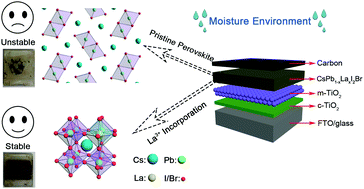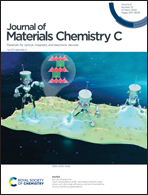Lattice reconstruction of La-incorporated CsPbI2Br with suppressed phase transition for air-processed all-inorganic perovskite solar cells†
Abstract
Inorganic CsPbI2Br halide perovskite has received extensive attention due to its excellent thermal stability and suitable bandgap for high-performance solar cells. However, CsPbI2Br can easily transform from the perovskite phase to the non-perovskite phase due to a water vapour-induced phase transition under ambient conditions, leading to a rapid degradation of device performance. Herein, we introduced lanthanum (La3+) ions into the lattice to stabilize the perovskite phase in CsPbI2Br-based all-inorganic solar cells. A power conversion efficiency of 8.03% was obtained at an optimized La3+-doping level of 2%, leading to a 27% efficiency improvement. Moreover, the La3+-doped solar cell retained 90% of its efficiency in ambient air for 400 h, showing a significantly enhanced moisture stability compared to that of the pristine (undoped) device. Detailed analysis indicates that La3+-ions can induce lattice shrinking and thus inhibit the formation of a non-perovskite phase, and enhance the charge carrier lifetime, which contribute to the improved moisture stability and efficiency. Our results indicate that highly stable all-inorganic solar cells can be produced in an air atmosphere, showing great potential for future commercialization.



 Please wait while we load your content...
Please wait while we load your content...